Trading Oversees (Part 1) How to Start Up an Exporting Business (Part 2)
VerifiedAdded on 2023/06/10
|11
|2693
|64
AI Summary
This report analyzes the global business environment, opportunities and challenges for global growth, trading blocs and agreements, and more. It also provides expert advice on starting an exporting business. The report focuses on Europe and includes a brochure attached. Course code, course name, and college/university are not mentioned.
Contribute Materials
Your contribution can guide someone’s learning journey. Share your
documents today.
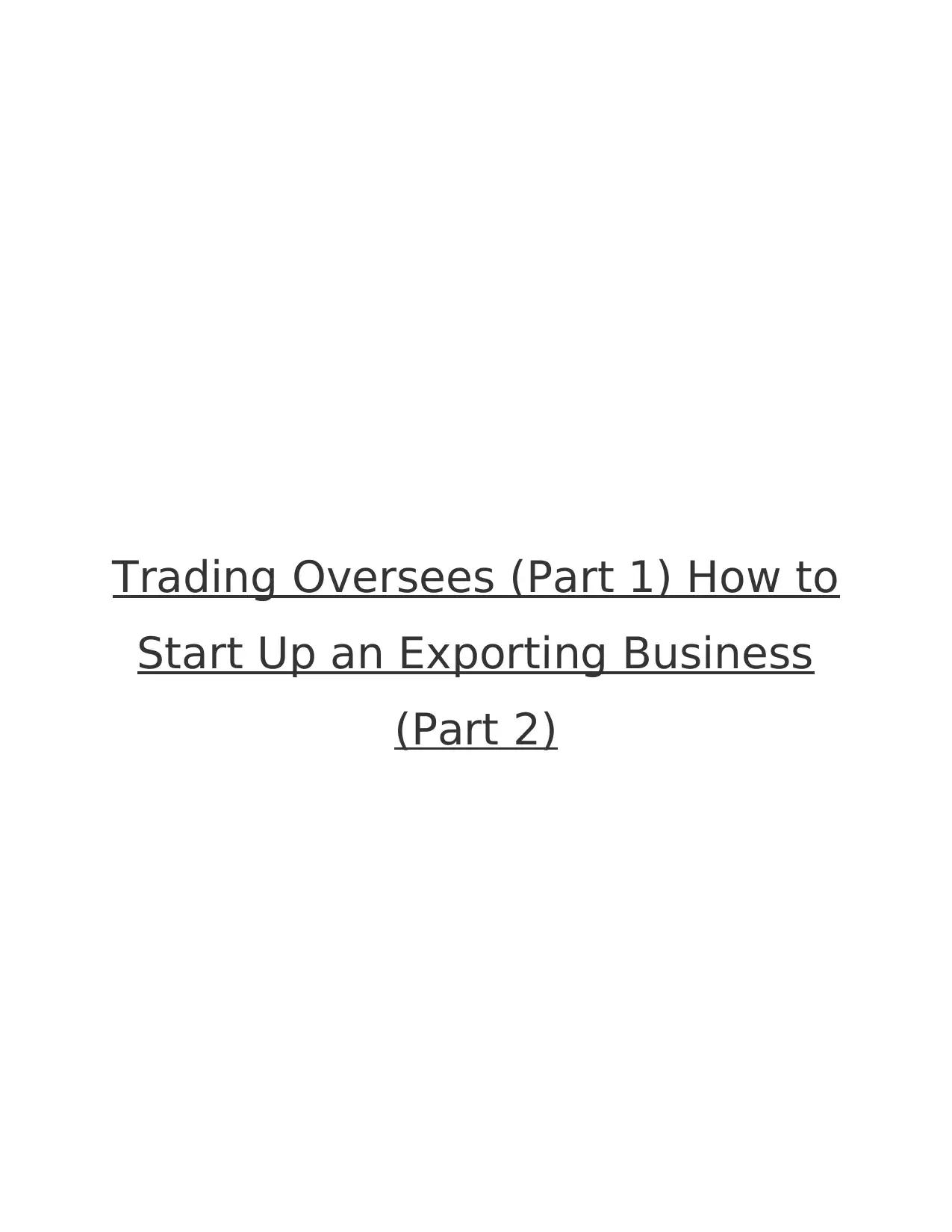
Trading Oversees (Part 1) How to
Start Up an Exporting Business
(Part 2)
Start Up an Exporting Business
(Part 2)
Secure Best Marks with AI Grader
Need help grading? Try our AI Grader for instant feedback on your assignments.

Table of Contents
INTRODUCTION...........................................................................................................................3
PART 1............................................................................................................................................3
Introduction to Europe.................................................................................................................3
Critically analysis global business environment and key global drivers ....................................3
Rationale for SMEs to expand business internationally..............................................................3
Opportunities and challenges for global growth..........................................................................4
Range of trading blocs and agreement and advantages for Europe.............................................5
Critically evaluation of trading blocs and agreements simulate and generate global growth.....6
CONCLUSION................................................................................................................................6
PART 2............................................................................................................................................6
Brochure attached........................................................................................................................6
REFERENCES................................................................................................................................7
INTRODUCTION...........................................................................................................................3
PART 1............................................................................................................................................3
Introduction to Europe.................................................................................................................3
Critically analysis global business environment and key global drivers ....................................3
Rationale for SMEs to expand business internationally..............................................................3
Opportunities and challenges for global growth..........................................................................4
Range of trading blocs and agreement and advantages for Europe.............................................5
Critically evaluation of trading blocs and agreements simulate and generate global growth.....6
CONCLUSION................................................................................................................................6
PART 2............................................................................................................................................6
Brochure attached........................................................................................................................6
REFERENCES................................................................................................................................7
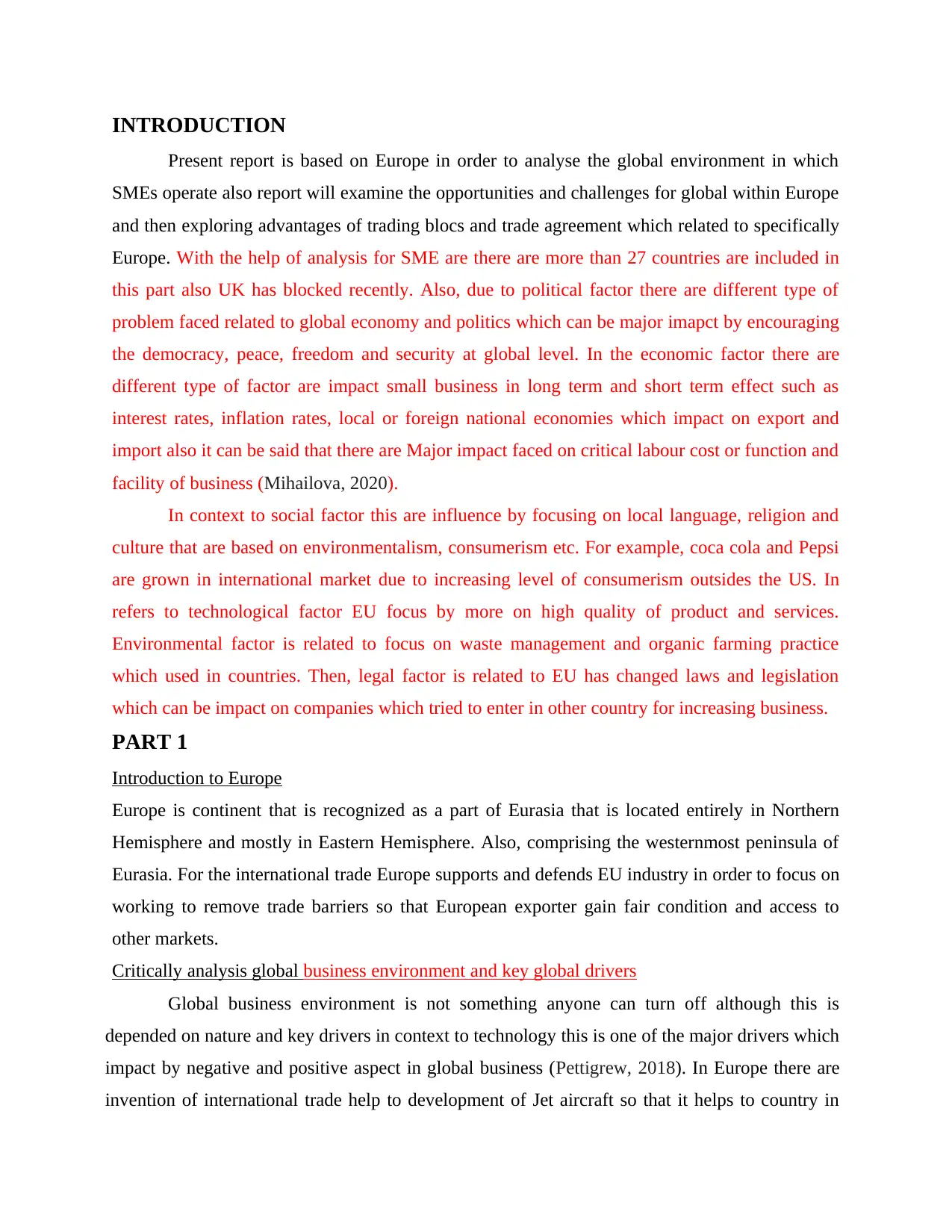
INTRODUCTION
Present report is based on Europe in order to analyse the global environment in which
SMEs operate also report will examine the opportunities and challenges for global within Europe
and then exploring advantages of trading blocs and trade agreement which related to specifically
Europe. With the help of analysis for SME are there are more than 27 countries are included in
this part also UK has blocked recently. Also, due to political factor there are different type of
problem faced related to global economy and politics which can be major imapct by encouraging
the democracy, peace, freedom and security at global level. In the economic factor there are
different type of factor are impact small business in long term and short term effect such as
interest rates, inflation rates, local or foreign national economies which impact on export and
import also it can be said that there are Major impact faced on critical labour cost or function and
facility of business (Mihailova, 2020).
In context to social factor this are influence by focusing on local language, religion and
culture that are based on environmentalism, consumerism etc. For example, coca cola and Pepsi
are grown in international market due to increasing level of consumerism outsides the US. In
refers to technological factor EU focus by more on high quality of product and services.
Environmental factor is related to focus on waste management and organic farming practice
which used in countries. Then, legal factor is related to EU has changed laws and legislation
which can be impact on companies which tried to enter in other country for increasing business.
PART 1
Introduction to Europe
Europe is continent that is recognized as a part of Eurasia that is located entirely in Northern
Hemisphere and mostly in Eastern Hemisphere. Also, comprising the westernmost peninsula of
Eurasia. For the international trade Europe supports and defends EU industry in order to focus on
working to remove trade barriers so that European exporter gain fair condition and access to
other markets.
Critically analysis global business environment and key global drivers
Global business environment is not something anyone can turn off although this is
depended on nature and key drivers in context to technology this is one of the major drivers which
impact by negative and positive aspect in global business (Pettigrew, 2018). In Europe there are
invention of international trade help to development of Jet aircraft so that it helps to country in
Present report is based on Europe in order to analyse the global environment in which
SMEs operate also report will examine the opportunities and challenges for global within Europe
and then exploring advantages of trading blocs and trade agreement which related to specifically
Europe. With the help of analysis for SME are there are more than 27 countries are included in
this part also UK has blocked recently. Also, due to political factor there are different type of
problem faced related to global economy and politics which can be major imapct by encouraging
the democracy, peace, freedom and security at global level. In the economic factor there are
different type of factor are impact small business in long term and short term effect such as
interest rates, inflation rates, local or foreign national economies which impact on export and
import also it can be said that there are Major impact faced on critical labour cost or function and
facility of business (Mihailova, 2020).
In context to social factor this are influence by focusing on local language, religion and
culture that are based on environmentalism, consumerism etc. For example, coca cola and Pepsi
are grown in international market due to increasing level of consumerism outsides the US. In
refers to technological factor EU focus by more on high quality of product and services.
Environmental factor is related to focus on waste management and organic farming practice
which used in countries. Then, legal factor is related to EU has changed laws and legislation
which can be impact on companies which tried to enter in other country for increasing business.
PART 1
Introduction to Europe
Europe is continent that is recognized as a part of Eurasia that is located entirely in Northern
Hemisphere and mostly in Eastern Hemisphere. Also, comprising the westernmost peninsula of
Eurasia. For the international trade Europe supports and defends EU industry in order to focus on
working to remove trade barriers so that European exporter gain fair condition and access to
other markets.
Critically analysis global business environment and key global drivers
Global business environment is not something anyone can turn off although this is
depended on nature and key drivers in context to technology this is one of the major drivers which
impact by negative and positive aspect in global business (Pettigrew, 2018). In Europe there are
invention of international trade help to development of Jet aircraft so that it helps to country in
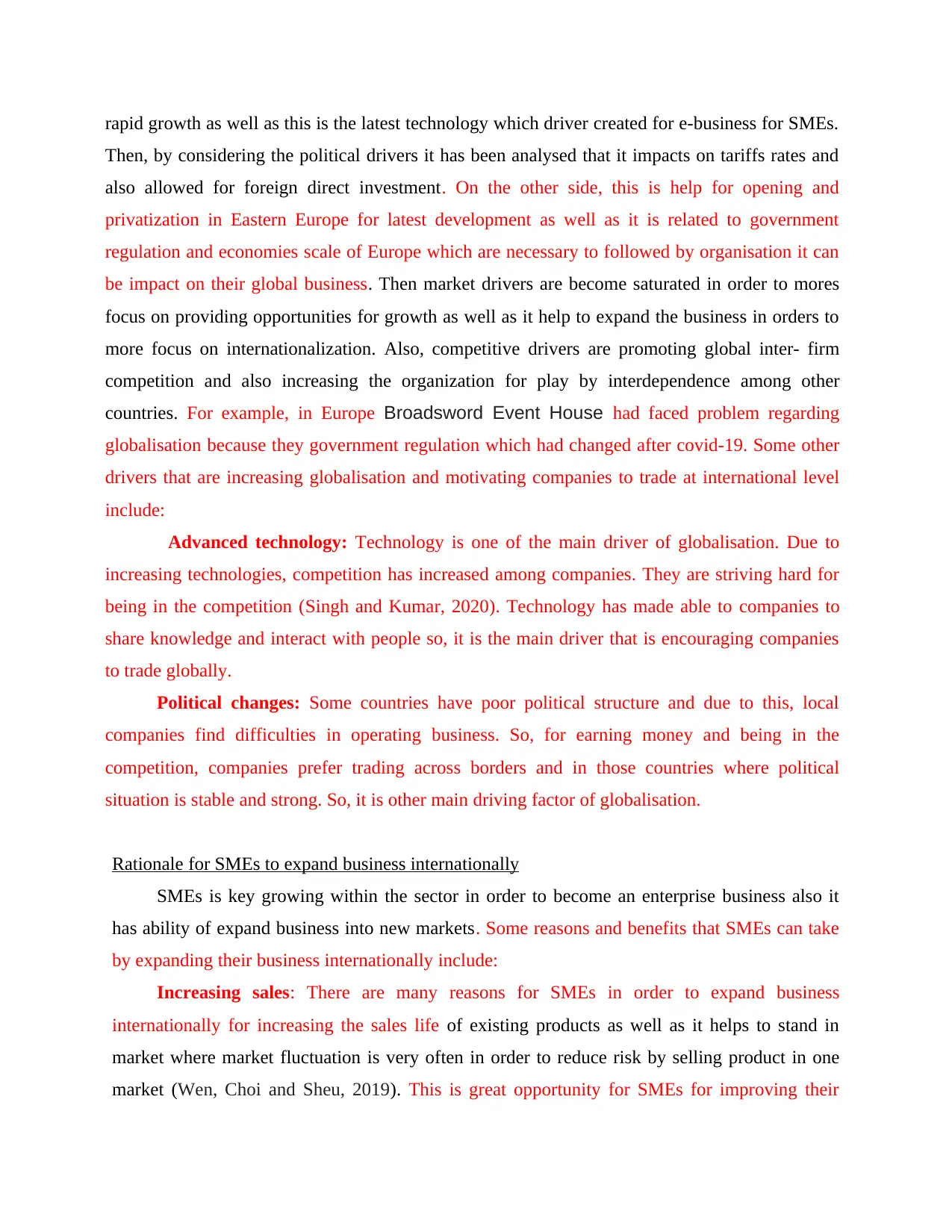
rapid growth as well as this is the latest technology which driver created for e-business for SMEs.
Then, by considering the political drivers it has been analysed that it impacts on tariffs rates and
also allowed for foreign direct investment. On the other side, this is help for opening and
privatization in Eastern Europe for latest development as well as it is related to government
regulation and economies scale of Europe which are necessary to followed by organisation it can
be impact on their global business. Then market drivers are become saturated in order to mores
focus on providing opportunities for growth as well as it help to expand the business in orders to
more focus on internationalization. Also, competitive drivers are promoting global inter- firm
competition and also increasing the organization for play by interdependence among other
countries. For example, in Europe Broadsword Event House had faced problem regarding
globalisation because they government regulation which had changed after covid-19. Some other
drivers that are increasing globalisation and motivating companies to trade at international level
include:
Advanced technology: Technology is one of the main driver of globalisation. Due to
increasing technologies, competition has increased among companies. They are striving hard for
being in the competition (Singh and Kumar, 2020). Technology has made able to companies to
share knowledge and interact with people so, it is the main driver that is encouraging companies
to trade globally.
Political changes: Some countries have poor political structure and due to this, local
companies find difficulties in operating business. So, for earning money and being in the
competition, companies prefer trading across borders and in those countries where political
situation is stable and strong. So, it is other main driving factor of globalisation.
Rationale for SMEs to expand business internationally
SMEs is key growing within the sector in order to become an enterprise business also it
has ability of expand business into new markets. Some reasons and benefits that SMEs can take
by expanding their business internationally include:
Increasing sales: There are many reasons for SMEs in order to expand business
internationally for increasing the sales life of existing products as well as it helps to stand in
market where market fluctuation is very often in order to reduce risk by selling product in one
market (Wen, Choi and Sheu, 2019). This is great opportunity for SMEs for improving their
Then, by considering the political drivers it has been analysed that it impacts on tariffs rates and
also allowed for foreign direct investment. On the other side, this is help for opening and
privatization in Eastern Europe for latest development as well as it is related to government
regulation and economies scale of Europe which are necessary to followed by organisation it can
be impact on their global business. Then market drivers are become saturated in order to mores
focus on providing opportunities for growth as well as it help to expand the business in orders to
more focus on internationalization. Also, competitive drivers are promoting global inter- firm
competition and also increasing the organization for play by interdependence among other
countries. For example, in Europe Broadsword Event House had faced problem regarding
globalisation because they government regulation which had changed after covid-19. Some other
drivers that are increasing globalisation and motivating companies to trade at international level
include:
Advanced technology: Technology is one of the main driver of globalisation. Due to
increasing technologies, competition has increased among companies. They are striving hard for
being in the competition (Singh and Kumar, 2020). Technology has made able to companies to
share knowledge and interact with people so, it is the main driver that is encouraging companies
to trade globally.
Political changes: Some countries have poor political structure and due to this, local
companies find difficulties in operating business. So, for earning money and being in the
competition, companies prefer trading across borders and in those countries where political
situation is stable and strong. So, it is other main driving factor of globalisation.
Rationale for SMEs to expand business internationally
SMEs is key growing within the sector in order to become an enterprise business also it
has ability of expand business into new markets. Some reasons and benefits that SMEs can take
by expanding their business internationally include:
Increasing sales: There are many reasons for SMEs in order to expand business
internationally for increasing the sales life of existing products as well as it helps to stand in
market where market fluctuation is very often in order to reduce risk by selling product in one
market (Wen, Choi and Sheu, 2019). This is great opportunity for SMEs for improving their
Secure Best Marks with AI Grader
Need help grading? Try our AI Grader for instant feedback on your assignments.
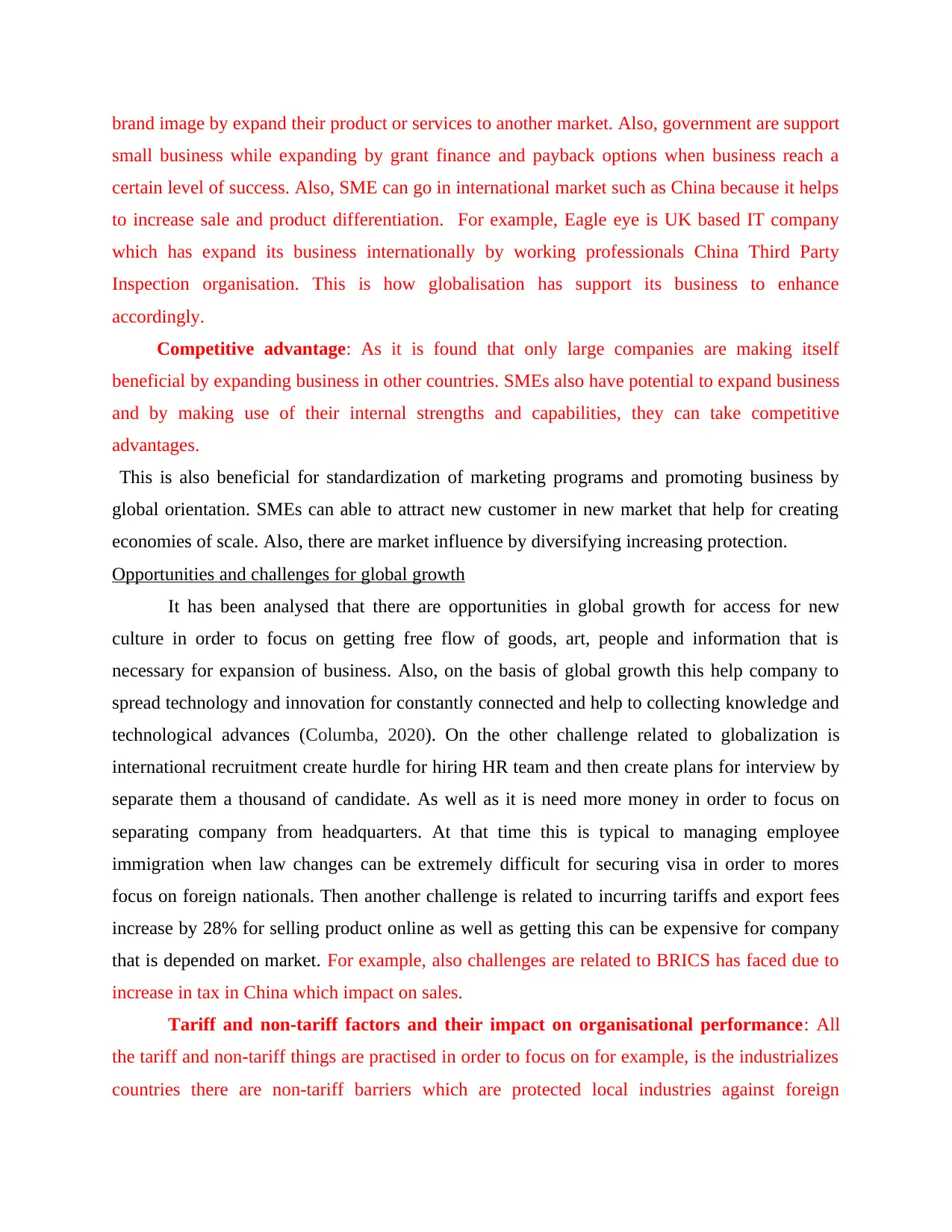
brand image by expand their product or services to another market. Also, government are support
small business while expanding by grant finance and payback options when business reach a
certain level of success. Also, SME can go in international market such as China because it helps
to increase sale and product differentiation. For example, Eagle eye is UK based IT company
which has expand its business internationally by working professionals China Third Party
Inspection organisation. This is how globalisation has support its business to enhance
accordingly.
Competitive advantage: As it is found that only large companies are making itself
beneficial by expanding business in other countries. SMEs also have potential to expand business
and by making use of their internal strengths and capabilities, they can take competitive
advantages.
This is also beneficial for standardization of marketing programs and promoting business by
global orientation. SMEs can able to attract new customer in new market that help for creating
economies of scale. Also, there are market influence by diversifying increasing protection.
Opportunities and challenges for global growth
It has been analysed that there are opportunities in global growth for access for new
culture in order to focus on getting free flow of goods, art, people and information that is
necessary for expansion of business. Also, on the basis of global growth this help company to
spread technology and innovation for constantly connected and help to collecting knowledge and
technological advances (Columba, 2020). On the other challenge related to globalization is
international recruitment create hurdle for hiring HR team and then create plans for interview by
separate them a thousand of candidate. As well as it is need more money in order to focus on
separating company from headquarters. At that time this is typical to managing employee
immigration when law changes can be extremely difficult for securing visa in order to mores
focus on foreign nationals. Then another challenge is related to incurring tariffs and export fees
increase by 28% for selling product online as well as getting this can be expensive for company
that is depended on market. For example, also challenges are related to BRICS has faced due to
increase in tax in China which impact on sales.
Tariff and non-tariff factors and their impact on organisational performance: All
the tariff and non-tariff things are practised in order to focus on for example, is the industrializes
countries there are non-tariff barriers which are protected local industries against foreign
small business while expanding by grant finance and payback options when business reach a
certain level of success. Also, SME can go in international market such as China because it helps
to increase sale and product differentiation. For example, Eagle eye is UK based IT company
which has expand its business internationally by working professionals China Third Party
Inspection organisation. This is how globalisation has support its business to enhance
accordingly.
Competitive advantage: As it is found that only large companies are making itself
beneficial by expanding business in other countries. SMEs also have potential to expand business
and by making use of their internal strengths and capabilities, they can take competitive
advantages.
This is also beneficial for standardization of marketing programs and promoting business by
global orientation. SMEs can able to attract new customer in new market that help for creating
economies of scale. Also, there are market influence by diversifying increasing protection.
Opportunities and challenges for global growth
It has been analysed that there are opportunities in global growth for access for new
culture in order to focus on getting free flow of goods, art, people and information that is
necessary for expansion of business. Also, on the basis of global growth this help company to
spread technology and innovation for constantly connected and help to collecting knowledge and
technological advances (Columba, 2020). On the other challenge related to globalization is
international recruitment create hurdle for hiring HR team and then create plans for interview by
separate them a thousand of candidate. As well as it is need more money in order to focus on
separating company from headquarters. At that time this is typical to managing employee
immigration when law changes can be extremely difficult for securing visa in order to mores
focus on foreign nationals. Then another challenge is related to incurring tariffs and export fees
increase by 28% for selling product online as well as getting this can be expensive for company
that is depended on market. For example, also challenges are related to BRICS has faced due to
increase in tax in China which impact on sales.
Tariff and non-tariff factors and their impact on organisational performance: All
the tariff and non-tariff things are practised in order to focus on for example, is the industrializes
countries there are non-tariff barriers which are protected local industries against foreign

competition also for the common example it can be said that there are some other problems
which are faced by small business company such as quotas, licence, foreign exchange and
restricted for import this kind of problem are faced by small company by increase the amount of
import deposits.
For example, there are 3% tariff increased on corn which would be 3% of tax that can be
added in order to maintain the cost paid by any domestic importer of corn from a foreign
country.
In context to Europe it can be said that there are different types of products are sold by
company which can be entered in European union also this is applicable only by protective
measures such as Levis has faced the problems in order to focus on high rate of tariff while
selling their product at Europe which can be classified as the code as well as it can be related to
carries all the information on duty or any applicable protective measures such as anti-dumping,
other formalities of export and import ( Christodoulou and Cullinane, 2019). Then it can be said
that there are some external trade statistics which can be related to non-tariff requirements.
Range of trading blocs and agreement and advantages for Europe
A trading bloc agreement is based on intergovernmental also it is work for regional
barriers to international trade that can be eliminated among participating states also allowing
them SME in Europe by reaching common agreement at lower trade barrier throughout the
group. For Europe advantages are related to business can access inputs at lower price than
allowing them for complete within Europe and abroad. Also, trades agreement is help for making
it easier for business in order to encourage the use of international standard for industrial
products so that it reduces the cost of doing business in order to promote international trades
(Warrish, 2019). Also, it has been analysed that European trade is one of the largest trade bloc in
the world that can be considered as the biggest exporter manufacturer of goods and services that
are related to the biggest import market over more than 100 countries. Then member of EU is
necessary for principle of good governance, human and labour right, environment protection.
For example, BRICS is continuing grow in order to focus on lower labour and production cost in
many counties company is growing in order to get foreign opportunities for expansion and
foreign direct investment.
which are faced by small business company such as quotas, licence, foreign exchange and
restricted for import this kind of problem are faced by small company by increase the amount of
import deposits.
For example, there are 3% tariff increased on corn which would be 3% of tax that can be
added in order to maintain the cost paid by any domestic importer of corn from a foreign
country.
In context to Europe it can be said that there are different types of products are sold by
company which can be entered in European union also this is applicable only by protective
measures such as Levis has faced the problems in order to focus on high rate of tariff while
selling their product at Europe which can be classified as the code as well as it can be related to
carries all the information on duty or any applicable protective measures such as anti-dumping,
other formalities of export and import ( Christodoulou and Cullinane, 2019). Then it can be said
that there are some external trade statistics which can be related to non-tariff requirements.
Range of trading blocs and agreement and advantages for Europe
A trading bloc agreement is based on intergovernmental also it is work for regional
barriers to international trade that can be eliminated among participating states also allowing
them SME in Europe by reaching common agreement at lower trade barrier throughout the
group. For Europe advantages are related to business can access inputs at lower price than
allowing them for complete within Europe and abroad. Also, trades agreement is help for making
it easier for business in order to encourage the use of international standard for industrial
products so that it reduces the cost of doing business in order to promote international trades
(Warrish, 2019). Also, it has been analysed that European trade is one of the largest trade bloc in
the world that can be considered as the biggest exporter manufacturer of goods and services that
are related to the biggest import market over more than 100 countries. Then member of EU is
necessary for principle of good governance, human and labour right, environment protection.
For example, BRICS is continuing grow in order to focus on lower labour and production cost in
many counties company is growing in order to get foreign opportunities for expansion and
foreign direct investment.
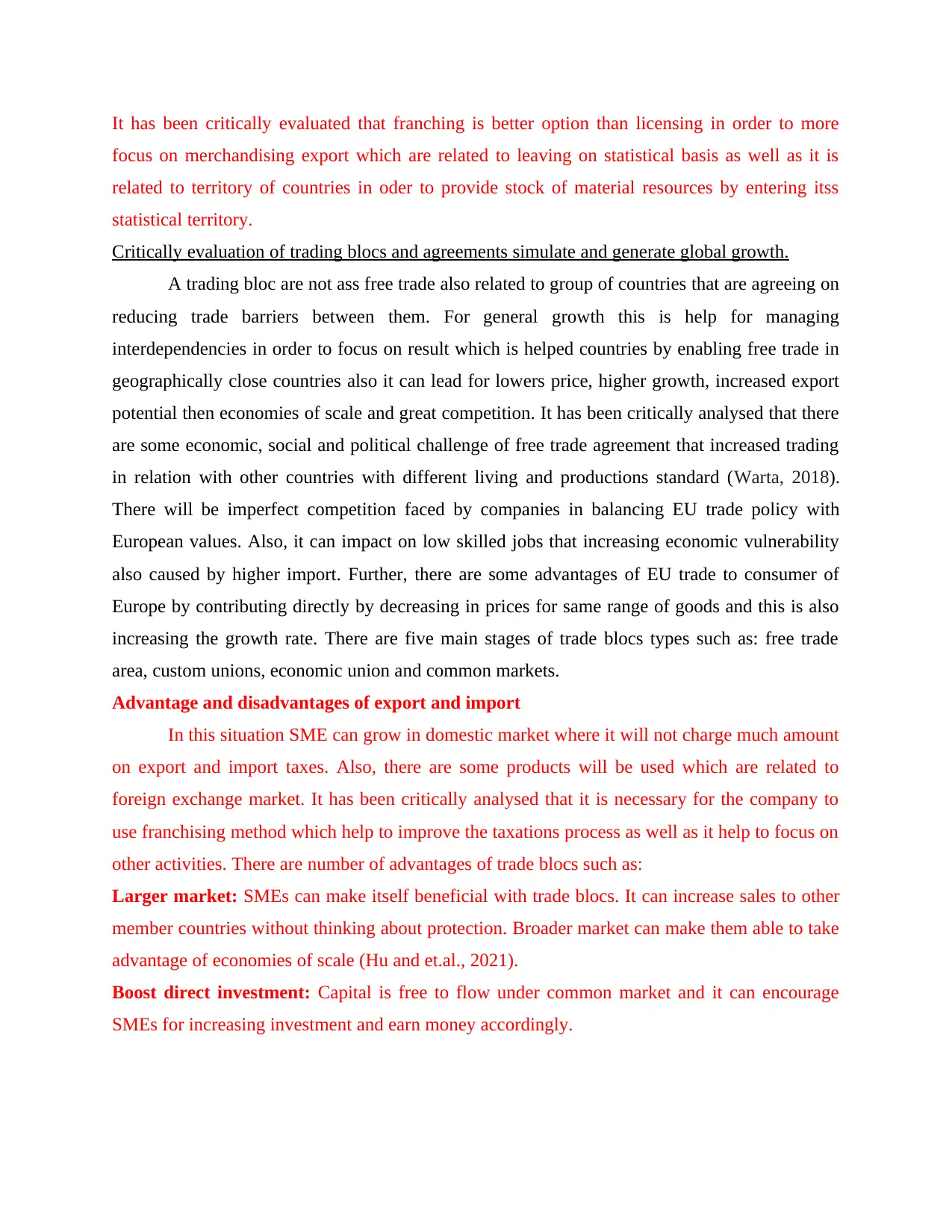
It has been critically evaluated that franching is better option than licensing in order to more
focus on merchandising export which are related to leaving on statistical basis as well as it is
related to territory of countries in oder to provide stock of material resources by entering itss
statistical territory.
Critically evaluation of trading blocs and agreements simulate and generate global growth.
A trading bloc are not ass free trade also related to group of countries that are agreeing on
reducing trade barriers between them. For general growth this is help for managing
interdependencies in order to focus on result which is helped countries by enabling free trade in
geographically close countries also it can lead for lowers price, higher growth, increased export
potential then economies of scale and great competition. It has been critically analysed that there
are some economic, social and political challenge of free trade agreement that increased trading
in relation with other countries with different living and productions standard (Warta, 2018).
There will be imperfect competition faced by companies in balancing EU trade policy with
European values. Also, it can impact on low skilled jobs that increasing economic vulnerability
also caused by higher import. Further, there are some advantages of EU trade to consumer of
Europe by contributing directly by decreasing in prices for same range of goods and this is also
increasing the growth rate. There are five main stages of trade blocs types such as: free trade
area, custom unions, economic union and common markets.
Advantage and disadvantages of export and import
In this situation SME can grow in domestic market where it will not charge much amount
on export and import taxes. Also, there are some products will be used which are related to
foreign exchange market. It has been critically analysed that it is necessary for the company to
use franchising method which help to improve the taxations process as well as it help to focus on
other activities. There are number of advantages of trade blocs such as:
Larger market: SMEs can make itself beneficial with trade blocs. It can increase sales to other
member countries without thinking about protection. Broader market can make them able to take
advantage of economies of scale (Hu and et.al., 2021).
Boost direct investment: Capital is free to flow under common market and it can encourage
SMEs for increasing investment and earn money accordingly.
focus on merchandising export which are related to leaving on statistical basis as well as it is
related to territory of countries in oder to provide stock of material resources by entering itss
statistical territory.
Critically evaluation of trading blocs and agreements simulate and generate global growth.
A trading bloc are not ass free trade also related to group of countries that are agreeing on
reducing trade barriers between them. For general growth this is help for managing
interdependencies in order to focus on result which is helped countries by enabling free trade in
geographically close countries also it can lead for lowers price, higher growth, increased export
potential then economies of scale and great competition. It has been critically analysed that there
are some economic, social and political challenge of free trade agreement that increased trading
in relation with other countries with different living and productions standard (Warta, 2018).
There will be imperfect competition faced by companies in balancing EU trade policy with
European values. Also, it can impact on low skilled jobs that increasing economic vulnerability
also caused by higher import. Further, there are some advantages of EU trade to consumer of
Europe by contributing directly by decreasing in prices for same range of goods and this is also
increasing the growth rate. There are five main stages of trade blocs types such as: free trade
area, custom unions, economic union and common markets.
Advantage and disadvantages of export and import
In this situation SME can grow in domestic market where it will not charge much amount
on export and import taxes. Also, there are some products will be used which are related to
foreign exchange market. It has been critically analysed that it is necessary for the company to
use franchising method which help to improve the taxations process as well as it help to focus on
other activities. There are number of advantages of trade blocs such as:
Larger market: SMEs can make itself beneficial with trade blocs. It can increase sales to other
member countries without thinking about protection. Broader market can make them able to take
advantage of economies of scale (Hu and et.al., 2021).
Boost direct investment: Capital is free to flow under common market and it can encourage
SMEs for increasing investment and earn money accordingly.
Paraphrase This Document
Need a fresh take? Get an instant paraphrase of this document with our AI Paraphraser
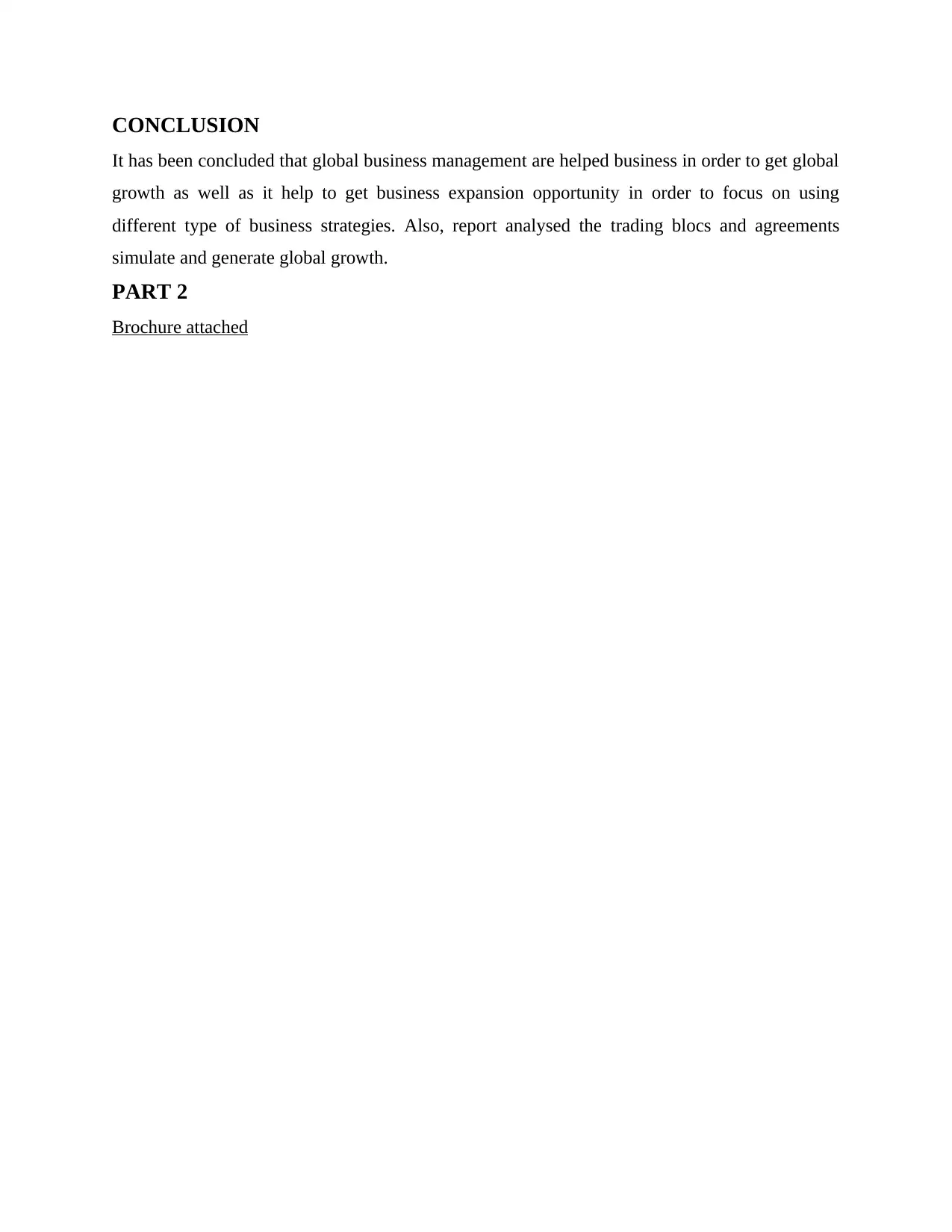
CONCLUSION
It has been concluded that global business management are helped business in order to get global
growth as well as it help to get business expansion opportunity in order to focus on using
different type of business strategies. Also, report analysed the trading blocs and agreements
simulate and generate global growth.
PART 2
Brochure attached
It has been concluded that global business management are helped business in order to get global
growth as well as it help to get business expansion opportunity in order to focus on using
different type of business strategies. Also, report analysed the trading blocs and agreements
simulate and generate global growth.
PART 2
Brochure attached
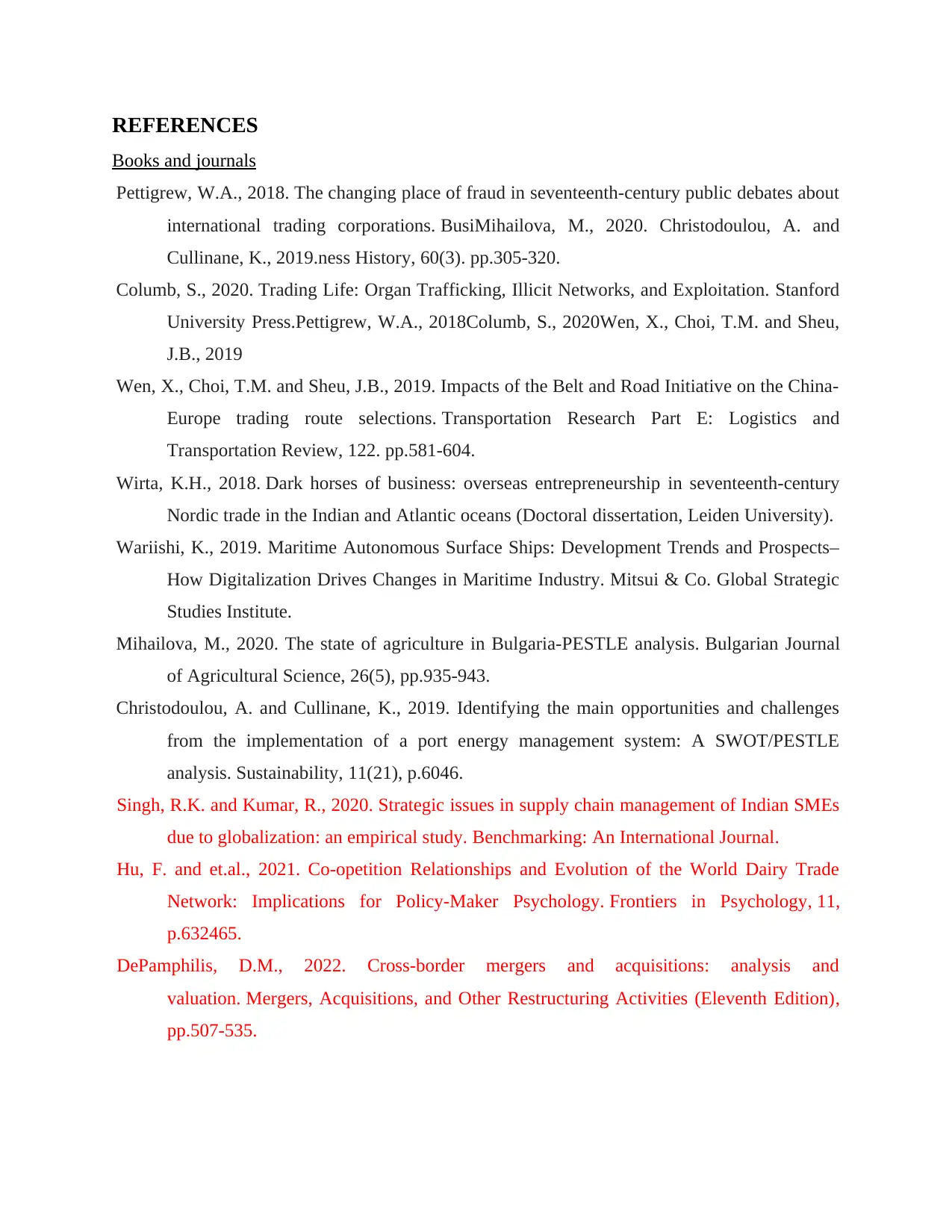
REFERENCES
Books and journals
Pettigrew, W.A., 2018. The changing place of fraud in seventeenth-century public debates about
international trading corporations. BusiMihailova, M., 2020. Christodoulou, A. and
Cullinane, K., 2019.ness History, 60(3). pp.305-320.
Columb, S., 2020. Trading Life: Organ Trafficking, Illicit Networks, and Exploitation. Stanford
University Press.Pettigrew, W.A., 2018Columb, S., 2020Wen, X., Choi, T.M. and Sheu,
J.B., 2019
Wen, X., Choi, T.M. and Sheu, J.B., 2019. Impacts of the Belt and Road Initiative on the China-
Europe trading route selections. Transportation Research Part E: Logistics and
Transportation Review, 122. pp.581-604.
Wirta, K.H., 2018. Dark horses of business: overseas entrepreneurship in seventeenth-century
Nordic trade in the Indian and Atlantic oceans (Doctoral dissertation, Leiden University).
Wariishi, K., 2019. Maritime Autonomous Surface Ships: Development Trends and Prospects–
How Digitalization Drives Changes in Maritime Industry. Mitsui & Co. Global Strategic
Studies Institute.
Mihailova, M., 2020. The state of agriculture in Bulgaria-PESTLE analysis. Bulgarian Journal
of Agricultural Science, 26(5), pp.935-943.
Christodoulou, A. and Cullinane, K., 2019. Identifying the main opportunities and challenges
from the implementation of a port energy management system: A SWOT/PESTLE
analysis. Sustainability, 11(21), p.6046.
Singh, R.K. and Kumar, R., 2020. Strategic issues in supply chain management of Indian SMEs
due to globalization: an empirical study. Benchmarking: An International Journal.
Hu, F. and et.al., 2021. Co-opetition Relationships and Evolution of the World Dairy Trade
Network: Implications for Policy-Maker Psychology. Frontiers in Psychology, 11,
p.632465.
DePamphilis, D.M., 2022. Cross-border mergers and acquisitions: analysis and
valuation. Mergers, Acquisitions, and Other Restructuring Activities (Eleventh Edition),
pp.507-535.
Books and journals
Pettigrew, W.A., 2018. The changing place of fraud in seventeenth-century public debates about
international trading corporations. BusiMihailova, M., 2020. Christodoulou, A. and
Cullinane, K., 2019.ness History, 60(3). pp.305-320.
Columb, S., 2020. Trading Life: Organ Trafficking, Illicit Networks, and Exploitation. Stanford
University Press.Pettigrew, W.A., 2018Columb, S., 2020Wen, X., Choi, T.M. and Sheu,
J.B., 2019
Wen, X., Choi, T.M. and Sheu, J.B., 2019. Impacts of the Belt and Road Initiative on the China-
Europe trading route selections. Transportation Research Part E: Logistics and
Transportation Review, 122. pp.581-604.
Wirta, K.H., 2018. Dark horses of business: overseas entrepreneurship in seventeenth-century
Nordic trade in the Indian and Atlantic oceans (Doctoral dissertation, Leiden University).
Wariishi, K., 2019. Maritime Autonomous Surface Ships: Development Trends and Prospects–
How Digitalization Drives Changes in Maritime Industry. Mitsui & Co. Global Strategic
Studies Institute.
Mihailova, M., 2020. The state of agriculture in Bulgaria-PESTLE analysis. Bulgarian Journal
of Agricultural Science, 26(5), pp.935-943.
Christodoulou, A. and Cullinane, K., 2019. Identifying the main opportunities and challenges
from the implementation of a port energy management system: A SWOT/PESTLE
analysis. Sustainability, 11(21), p.6046.
Singh, R.K. and Kumar, R., 2020. Strategic issues in supply chain management of Indian SMEs
due to globalization: an empirical study. Benchmarking: An International Journal.
Hu, F. and et.al., 2021. Co-opetition Relationships and Evolution of the World Dairy Trade
Network: Implications for Policy-Maker Psychology. Frontiers in Psychology, 11,
p.632465.
DePamphilis, D.M., 2022. Cross-border mergers and acquisitions: analysis and
valuation. Mergers, Acquisitions, and Other Restructuring Activities (Eleventh Edition),
pp.507-535.

Secure Best Marks with AI Grader
Need help grading? Try our AI Grader for instant feedback on your assignments.

1 out of 11
Related Documents
Your All-in-One AI-Powered Toolkit for Academic Success.
+13062052269
info@desklib.com
Available 24*7 on WhatsApp / Email
![[object Object]](/_next/static/media/star-bottom.7253800d.svg)
Unlock your academic potential
© 2024 | Zucol Services PVT LTD | All rights reserved.





